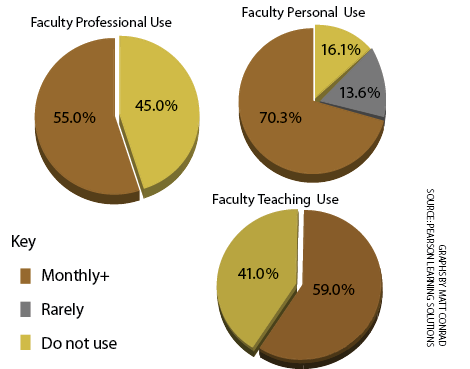University professors are using social media more as digital communication becomes more commonplace.
A new study released this month by Pearson Learning Solutions and the Babson Survey Research Group found that a majority of the faculty members who responded to the survey use social media both personally and professionally. The survey of more than 8,000 faculty members also found that 41 percent of college professors use social media in the classroom, up from just about 34 percent in 2012.
Blair Kelley, an associate professor of history, said professors can use Twitter to give students a broader sense of who they are as scholars.
“I think people are starting to listen,” Kelley said. “When I first joined Twitter, people asked why I would want so many followers. They thought it was a violation of privacy, but I think people are realizing that what you put on there is under your control. I see more and more academics joining in the broad conversation now.”
Kelley said she joined Twitter four years ago to prove to a friend it wasn’t worth the time. However, once she got her account, she loved it.
“I’ve been using it ever since,” Kelley said. “It’s not something I demand of students because not everyone feels comfortable using Twitter. Some feel it’s personal, so I don’t make it part of a student’s grade.”
Kelley said she likes social media because she can share things about herself in real life.
“It’s good for discussion because I can pose questions to broader topics outside the classroom,” Kelley said. “I try to keep things fun. I tweet about going to the gym or about an awards show I’m watching just so people know I’m human.”
Still, Kelley said she draws strict lines to govern how she behaves online. She doesn’t list her husband’s name or children’s names nor does she ever list her location when posting.
“I agreed to do this, not my husband or children,” Kelley said. “I don’t jump into personal or relationship-based conversations. I act like a professor. If I wouldn’t engage in it in class, I don’t engage online.”
Kelley said she sees social media use in other classrooms as well, particularly through Facebook or blogging. She also said she can envision a design professor using Instagram or Vine to show off his or her projects.
Still, she said she’s more of a Twitter person.
“Facebook is too slow-moving for me,” Kelley said.
Steven Greene, a professor of public and international affairs, said that he does use social media but not as a teaching tool. Greene said he sees a concern among faculty members about what’s appropriate on social media and what lines should be drawn between professors and students.
“I use social media a lot, but I don’t think I can say to students, ‘Request me on Facebook,’ or ‘Follow my Twitter,’” Greene said. “I write a blog, mostly about politics, and my Twitter feed tweets links to my posts. But I don’t feel comfortable requiring students to read my blog.”
Greene said this is because he likes to blog unfiltered.
“I could very much envision writing a blog that I would expect students to follow,” Greene said. “That would just be much less fun for me.”
Not everyone uses the traditional platforms, though. Martin Dulberg, a senior coordinator for Distance Education & Learning Technology Applications at N.C. State, said he sees a future blending of social media and teaching practices – but not with common social networks.
“I don’t think it will be in the form of Facebook or Twitter, but I think there are some very educational-based platforms out there,” Dulberg said.
Dulberg said that when he taught classes at N.C. State, he utilized forums. He said he would post practice problems on the forums and let students communicate with each other as they tried to solve them.
“It was great,” Dulberg said. “I would check my course and see that a student had asked a question about the course. Before I even noticed the question, another student had responded with the answer.”
Dulberg also said he can envision students using Collaborate, a Blackboard video conferencing tool DELTA offers to all students and faculty, to work with each other remotely on projects.
The Pearson Learning Solutions survey found that the top five social media platforms used personally by professors are Facebook, LinkedIn, blogs, podcasts and Twitter, with Facebook being the most popular. Usage was spread nearly evenly across disciplines and age ranges.
LinkedIn was the most popular network used professionally, and blogs were the most popular style of social media used in the classroom. The most common age range for faculty to use social media in the classroom was 35 – 44.
Kelley said that looking forward, the means by which educators use social media will likely change.
“Remember MySpace?” Kelley said. “It’s gone from relevance now. Twitter may one day be irrelevant, and we’ll have to move on. But we’ll always look for ways to broaden what we do in the classroom.”








